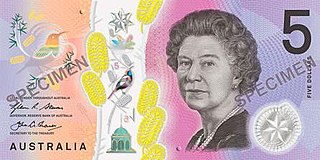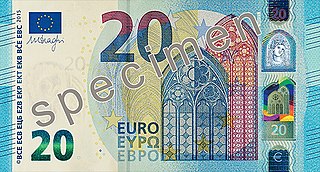
The ruble or rouble is the currency of the Russian Federation. The ruble is subdivided into 100 kopecks. It is used in Russia as well as in the parts of Ukraine under Russian military occupation and in Russian-occupied parts of Georgia.

The tenge is the currency of Kazakhstan. It is divided into 100 tiyn.

Security printing is the field of the printing industry that deals with the printing of items such as banknotes, cheques, passports, tamper-evident labels, security tapes, product authentication, stock certificates, postage stamps and identity cards. The main goal of security printing is to prevent forgery, tampering, or counterfeiting. More recently many of the techniques used to protect these high-value documents have become more available to commercial printers, whether they are using the more traditional offset and flexographic presses or the newer digital platforms. Businesses are protecting their lesser-value documents such as transcripts, coupons and prescription pads by incorporating some of the features listed below to ensure that they cannot be forged or that alteration of the data cannot occur undetected.
The Canadian twenty-dollar note is one of the most common banknotes of the Canadian dollar; it is the primary banknote dispensed from Canadian automated teller machines (ATMs). The newest version, the Frontier Series polymer note, was released to the general public on November 7, 2012, replacing the banknote from the Canadian Journey Series.

The Central Bank of the Russian Federation, which brands itself as Bank of Russia and is also commonly referred to in English as the Central Bank of Russia (CBR), is the central bank of the Russian Federation. The bank was established on July 13, 1990. It claims the legacy of the State Bank of the Russian Empire (1860-1920) and of the Soviet Gosbank (1921-1992), even though both institutions covered a significant larger territorial scope.

The som is the currency of Kyrgyzstan.

The ruble, rouble or rubel is the currency of Belarus. It is subdivided into 100 kopecks.

The Canadian fifty-dollar note is one of the most common banknotes of the Canadian dollar. It is sometimes dispensed by ATMs but not as commonly as the $20 note.

The Canadian one-hundred-dollar note is one of five banknotes of the Canadian dollar. It is the highest-valued and least-circulated of the notes since the thousand-dollar note was gradually removed from circulation starting in 2000.
A currency detector or currency validator is a device that determines whether notes or coins are genuine or counterfeit. These devices are used in a wide range of automated machines, such as retail kiosks, supermarket self checkout machines, arcade gaming machines, payphones, launderette washing machines, car park ticket machines, automatic fare collection machines, public transport ticket machines, and vending machines.

The Australian five-dollar note was first issued on 29 May 1967, fifteen months after the currency was changed from the pound to the dollar on 14 February 1966. It was a new denomination with mauve colouration – the pre-decimal system had no denomination with a value of £21⁄2. The first polymer version of the note was introduced on 7 July 1992. A major design update was issued on 1 September 2016, with a minor update to the signatures in 2019.
New Zealand dollar banknotes are the banknotes in circulation in New Zealand, the Cook Islands, Tokelau, Niue and the Pitcairn Islands, denominated in the New Zealand dollar. They are issued by the Reserve Bank of New Zealand and since 1999 have been made of polymer.

The five-euro note (€5) is the lowest value euro banknote. It has been used since the introduction of the euro in 2002. The note is used in the 25 countries that have it as their sole currency, which countries have a total population of about 343 million currently. In July 2023, there were approximately 2,159,000,000 five-euro banknotes in circulation around the eurozone. It is the fifth-most widely circulated denomination, accounting for 7.2% of the total banknotes. Estimates suggest that the average life of a five-euro banknote is less than a year before it is replaced due to wear.

The ten euro note (€10) is the second-lowest value euro banknote and has been used since the introduction of the euro in 2002. The note is used in the 25 countries which have it as their sole currency ; with a population of about 343 million. In July 2023, there were approximately 3,033,000,000 ten euro banknotes in circulation around the eurozone. It is the fourth most widely circulated denomination, accounting for 10.2% of the total banknotes. Estimates suggest that the average life of a ten euro banknote is about 1.5 years before it is replaced due to wear.

The twenty euro note (€20) is the third-lowest value euro banknote and has been used since the introduction of the euro in 2002. The note is used by the 25 countries and a population of 343 million as their sole currency, with 23 legally adopting it. In July 2023, there were approximately 4,837,000,000 twenty euro banknotes in circulation around the eurozone. It is the second most widely circulated denomination, accounting for 16.3% of the total banknotes. Estimates suggest that the average life of a twenty euro banknote is about two years before it is replaced due to wear.

The fifty euro note (€50) is one of the middle value euro banknotes and has been used since the introduction of the euro in 2002. The note is used by some 343 million Europeans and in the 25 countries which have the euro as their sole currency. In July 2023, there were about 14,523,000,000 fifty euro banknotes in circulation in the eurozone. It is by far the most widely circulated denomination, accounting for almost half (49.0%) of the total banknotes. Estimates suggest that the average life of a fifty euro banknote is about four years before it is replaced due to wear.

The two hundred euro note (€200) is the second highest value euro banknote and has been used since the introduction of the euro in 2002. The note is used in the 26 countries that have the euro as their sole currency ; with a population of about 343 million. In July 2023, there were about 849,000,000 €200 banknotes in circulation around the eurozone. It is the second least widely circulated denomination, accounting for 2.9% of the total banknotes.

The Russian five-ruble banknote was introduced in 1998 and then discontinued in 2001 because of inflation. Until 2023, five-ruble notes were very hard to find in general circulation. The most prominent color of the note is light-green in the background. In late 2022, the Central Bank of Russia announced that the bill had been reintroduced alongside the ten-ruble banknote. It was returned to circulation in January 2023.
Otkritie Holding, formerly Otkritie Financial Corporation and Otkrytiye investment group, is a Russian private financial group established in 1995 as VEO-Invest company.
Modification of banknotes of the Russian ruble (2022–2025) is renewal of Bank of Russia banknotes with a nominal value of 10 to 5000 rubles. The previous banknotes (1997) are planned to be withdrawn from circulation approximately by 2035.
















